To calculate your jewelry making costs accurately, you’ll need to track four key components: direct material expenses (gold, silver, gemstones), labor hours and wages including benefits, overhead costs like rent and utilities, and equipment depreciation. Use the formula: Total Manufacturing Cost = Direct Materials + Direct Labor + Manufacturing Overhead, then divide by units produced for cost per piece. Regular tracking and market price updates guarantee profitable pricing strategies while accounting for variations between different jewelry types and complexity levels.
Understanding Direct Material Costs in Jewelry Making
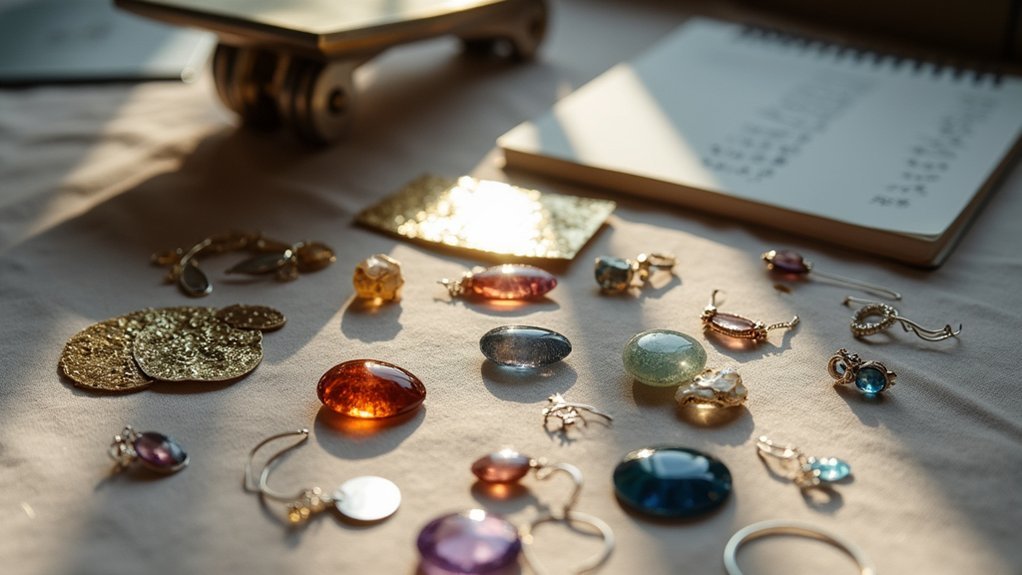
Precision matters when calculating direct material costs for your jewelry-making business. You’ll need to track expenses associated with raw materials like gold, silver, platinum, and gemstones, which fluctuate based on market prices.
Tracking fluctuating gold, silver, platinum, and gemstone prices with precision ensures accurate direct material cost calculations for profitable jewelry making.
Use this formula: Total Direct Material Cost = Cost of Raw Materials Purchased + Beginning Inventory – Ending Inventory.
Effective inventory management is essential since precious metal and gemstone prices change daily.
Don’t forget to include consumable manufacturing supplies such as solder, wire, and tools in your calculations, as these contribute to each piece’s total cost.
Regularly update your material costs to maintain accurate pricing. This guarantees you’ll cover all expenses while protecting your profitability in an industry where raw material values constantly shift.
Calculating Labor Hours and Wages for Jewelry Production
While material costs form the foundation of your jewelry pricing, calculating labor hours and wages requires equally meticulous tracking to guarantee profitability.
You’ll need to calculate labor costs by recording total hours worked across every production process stage – design, crafting, polishing, and finishing. Don’t forget preparation and cleanup time, as these contribute to your manufacturing costs.
Track each employee’s hourly wage, accounting for skill levels and experience differences. Calculate the fully burdened cost by including direct and indirect costs like payroll taxes, insurance, and benefits.
Time-tracking software helps document efficiency and identifies cost-saving opportunities. Multiply total hours worked by the complete labor rate to determine accurate wages.
Regularly review these calculations as production volume and efficiency change to maintain profitable operations.
Identifying and Measuring Overhead Expenses

You’ll need to identify all manufacturing overhead components that indirectly support your jewelry production, including utilities, rent, equipment depreciation, and supervisory salaries.
Calculate your overhead rate by dividing total overhead costs by sales, then multiplying by 100 to get a percentage.
You must then allocate these indirect costs across your products using appropriate methods like machine hours or labor hours to guarantee accurate pricing decisions.
Manufacturing Overhead Components
Manufacturing overhead represents the hidden costs that can make or break your product profitability calculations. These indirect manufacturing costs include utilities, rent, equipment depreciation, property taxes on manufacturing facilities, and insurance premiums for equipment.
You’ll also need to account for salaries paid to supervisors and maintenance staff as key components of total manufacturing overhead.
To calculate total manufacturing cost accurately, identify all overhead expenses incurred during your production period and sum them together. This gives you the total overhead cost that you’ll need to allocate overhead across your products.
You can then allocate overhead using an allocation base like direct labor hours or machine hours, ensuring these production costs are distributed consistently across all manufactured items.
Overhead Rate Calculation
Once you’ve identified all manufacturing overhead components, you’ll need to calculate your overhead rate to properly distribute these costs across your products.
Start by summing all your overhead expenses for a specific period, including utilities, depreciation, and indirect materials. This gives you your total manufacturing overhead costs.
Next, choose an allocation base such as direct labor hours or machine hours. Divide your total overhead by this allocation base to determine your rate. For instance, if monthly overhead expenses equal $60,000 and you have 4,000 direct labor hours, your overhead rate becomes $15 per hour.
Remember to regularly update your calculations as overhead costs and production volumes fluctuate, ensuring accurate allocation for pricing and profitability decisions.
Indirect Cost Allocation
While calculating overhead rates provides the foundation for cost allocation, identifying and measuring the specific overhead expenses that make up your manufacturing costs requires a systematic approach.
Start by categorizing your manufacturing overhead into indirect costs like utilities, rent, depreciation, and supervisory salaries that can’t be traced to specific products. You’ll need to allocate indirect costs using your predetermined overhead rate, dividing total estimated overhead by your chosen activity base.
Consider implementing activity-based costing for more precise overhead allocation, as it assigns costs based on actual resource consumption. This method improves accuracy in product pricing and enhances profitability analysis.
Remember to regularly review your allocation methods to reflect changes in production processes, ensuring your cost management remains effective and supports accurate financial reporting.
Determining Tool and Equipment Depreciation Costs

You’ll need to choose the right depreciation method for your tools and equipment, with straight-line and double-declining balance being the most common approaches.
Once you’ve selected your method, you can calculate the annual depreciation expense by applying the appropriate formula to each asset’s cost, salvage value, and useful life.
Finally, you’ll allocate these depreciation costs as overhead expenses across your production activities to accurately reflect the true cost of manufacturing your products.
Equipment Depreciation Methods
When calculating making costs, equipment depreciation represents one of your most significant ongoing expenses that directly impacts your bottom line.
You’ll need to choose between three primary equipment depreciation methods to accurately determine these costs. The straight-line method spreads your equipment’s cost evenly across its useful life, making calculations straightforward for financial reporting.
However, the declining balance method accelerates depreciation in earlier years, which often better reflects actual equipment value loss. You’ll also find the units of production method useful for equipment tied to specific output levels.
Your annual depreciation expense depends on accurately estimating useful life and salvage value. Proper cost management requires regularly reviewing these estimates to guarantee your financial reporting reflects true asset values over time.
Calculating Annual Depreciation
Once you’ve selected your depreciation method, calculating the actual annual depreciation amounts becomes your next step in determining accurate tool and equipment costs.
Using the straight-line method, you’ll subtract the salvage value from your equipment’s original cost, then divide by its useful life. For example, a $15,000 machine with a $3,000 salvage value and 8-year useful life generates $1,500 annual depreciation ($12,000 ÷ 8 years).
You’ll record this depreciation expense annually for financial reporting purposes.
Remember to monitor market conditions and equipment performance regularly, as these factors might require adjusting your useful life estimates or salvage value calculations to maintain accurate equipment costs and guarantee your depreciation reflects reality.
Allocating Depreciation Overhead
After establishing your annual depreciation amounts, properly allocating these costs across your operations becomes critical for accurate project pricing and profitability analysis.
You’ll need to distribute depreciation overhead based on how each asset contributes to specific projects or production lines. Track the useful life and cost of each piece of equipment to guarantee precise allocation.
Consider usage hours, production volume, or square footage as allocation methods. If your $10,000 machine with five-year useful life generates $1,800 annual expense, you’d allocate this cost proportionally across projects using that equipment.
Document these allocations meticulously for financial reporting compliance. Regular reviews ascertain your depreciation overhead reflects actual asset utilization, maintaining accuracy in your making costs calculations.
Tracking Precious Metal and Gemstone Expenses
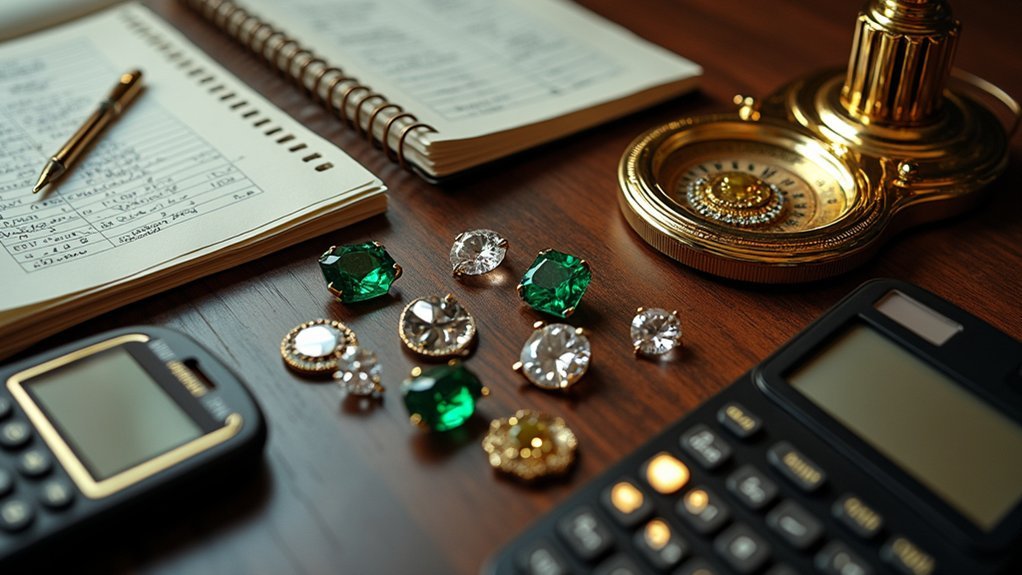
Because precious metals and gemstones represent the most significant portion of your jewelry-making costs, you’ll need a systematic approach to track every expense associated with these materials.
Understanding how to calculate these direct costs and indirect expenses guarantees accurate pricing strategies as production increases.
Calculating both direct and indirect costs ensures your pricing strategy remains profitable as your jewelry business scales up.
Your manufacturing cost includes more than just raw materials. Here’s how to track everything effectively:
- Record complete purchase details – Document the exact weight, purity, and carat alongside purchase prices, taxes, shipping fees, and handling charges to capture your true total expenses.
- Update market valuations regularly – Monitor precious metal and gemstone price fluctuations to maintain current material costs assessments.
- Calculate the total finished piece cost – Include labor, overhead, and additional materials when determining your final costs associated with each completed item.
Allocating Studio Rent and Utility Costs
When you’re running a jewelry-making business from a dedicated studio space, allocating rent and utility costs becomes essential for understanding your true production expenses.
Start by allocating overhead through dividing your monthly rent by the number of workspaces or production hours you utilize. This approach helps you determine the total cost per unit of usage.
For utility costs, measure actual consumption using sub-meters when possible to allocate studio rent and utilities accurately. If direct measurements aren’t available, use fixed allocation percentages based on your production area’s square footage versus total studio space.
Document all allocation methods and calculations to maintain transparency in your financial reporting.
Review these methods periodically to reflect changes in production volume or equipment needs.
Computing Total Manufacturing Cost Per Piece
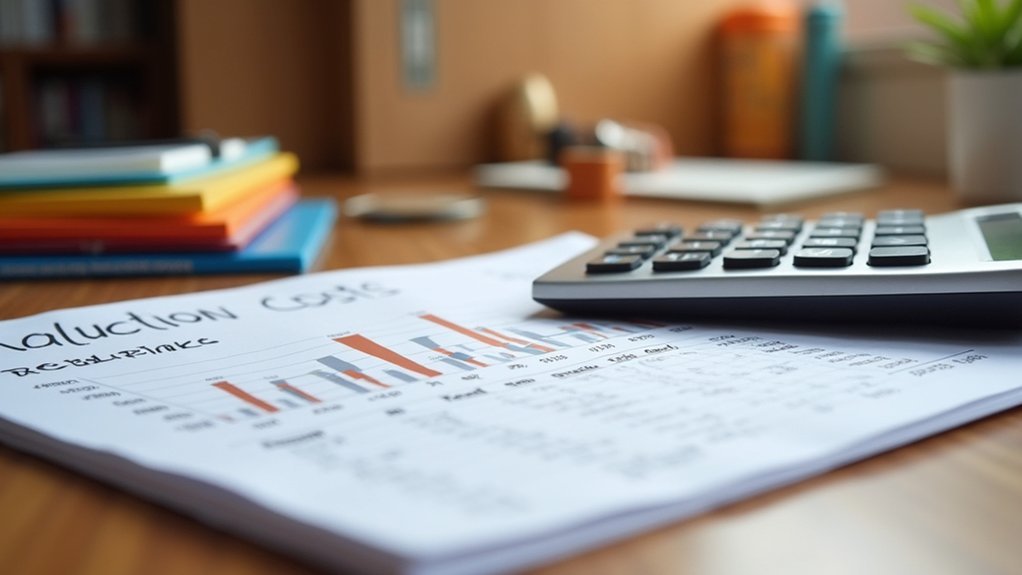
Computing your total manufacturing cost per piece requires combining all production expenses into a single, extensive figure.
You’ll need to gather three essential cost components: direct materials, direct labor, and manufacturing overhead that you’ve previously allocated.
Follow this systematic approach:
Follow this systematic approach to accurately calculate your manufacturing cost per piece and maintain profitability.
- Sum all manufacturing costs – Add your direct materials, direct labor, and manufacturing overhead together to determine your total manufacturing cost.
- Count units produced – Accurately track your production quantities during the same period you’re calculating costs.
- Apply the formula – Divide total manufacturing cost by units produced to get your cost per piece.
For instance, if you’ve spent $47,000 total and produced 1,000 units, your cost per piece equals $47.
Maintain accurate tracking and regularly update your data as material prices and production volumes fluctuate.
Analyzing Cost Variations Across Different Jewelry Types
Since jewelry manufacturing encompasses diverse materials and techniques, you’ll discover considerable cost variations between different piece types. Understanding production costs and indirect costs becomes essential when comparing gold versus silver pieces, as raw material prices fluctuate dramatically.
Your direct labor expenses will vary markedly between handcrafted designs requiring specialized skills and simpler manufactured pieces.
When calculating total manufacturing costs, you’ll find that gemstone jewelry demands more specialized equipment than basic metalwork, affecting your cost per unit calculations. Variable costs change based on piece complexity—intricate designs require additional production hours, increasing total manufacturing cost requires careful tracking.
Your supply chain decisions greatly impact expenses; choosing diamonds versus cubic zirconia creates considerable cost differences that directly affect your final pricing strategy and profitability margins.
Frequently Asked Questions
How Do You Calculate Cost of Making?
You’ll calculate making costs by adding direct materials, direct labor, and manufacturing overhead together. Start with raw materials inventory, add purchases, subtract ending inventory, then include wages and indirect costs like utilities.
How Do You Determine the Correct Cost of Production?
You’ll determine correct production costs by calculating raw materials (beginning inventory plus purchases minus ending inventory), adding direct labor expenses, including manufacturing overhead, then summing these three components together.
Which Cost Calculation Method Is Most Accurate?
You’ll find Activity-Based Costing (ABC) most accurate since it allocates overhead costs based on actual activities driving expenses, rather than arbitrary percentages, giving you precise product costs for better decision-making.
How Do You Figure Out How Much Something Costs to Make?
You’ll calculate raw materials costs first, then add direct labor expenses including wages and benefits. Next, include manufacturing overhead like utilities and equipment depreciation. Finally, sum all three components for total manufacturing cost.
In Summary
You’ll achieve profitable pricing by tracking every expense from materials to overhead. Don’t overlook small costs like utilities or tool depreciation—they’ll add up quickly. Calculate your true hourly rate including benefits and taxes, then apply it consistently across projects. Review your costs monthly and adjust for market changes in precious metals. Accurate costing isn’t just accounting—it’s protecting your business and ensuring you’re paid fairly for your craftsmanship.


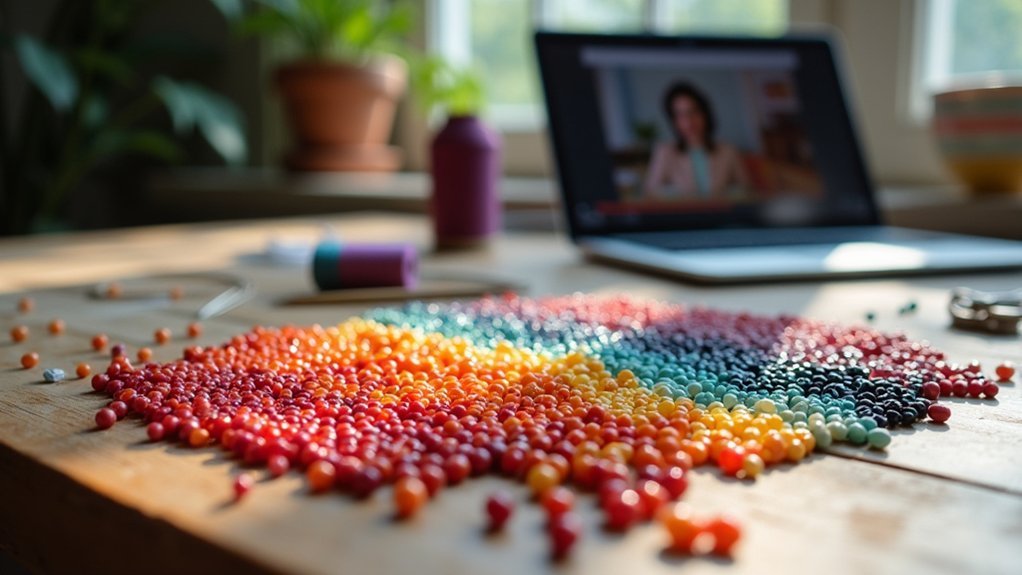
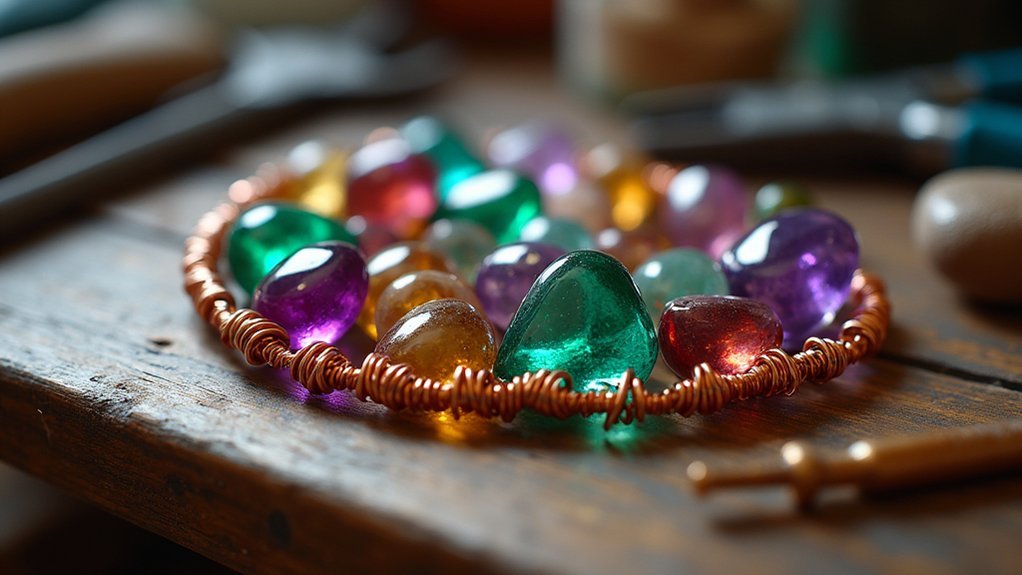

Leave a Reply